Cavtat is a small coastal town in southern Croatia, 20 kilometers (12 miles) southeast of Dubrovnik, known for its blend of cultural heritage, seaside charm, and easy accessibility.
Cavtat combines a compact old town, pebble beaches, and a lively promenade with cafés and seafood restaurants. Visitors come for its historic charm, churches, and the Vlaho Bukovac House, as well as outdoor experiences like walking the Rat Peninsula trail, swimming in Tiha Bay, and exploring nearby islands.
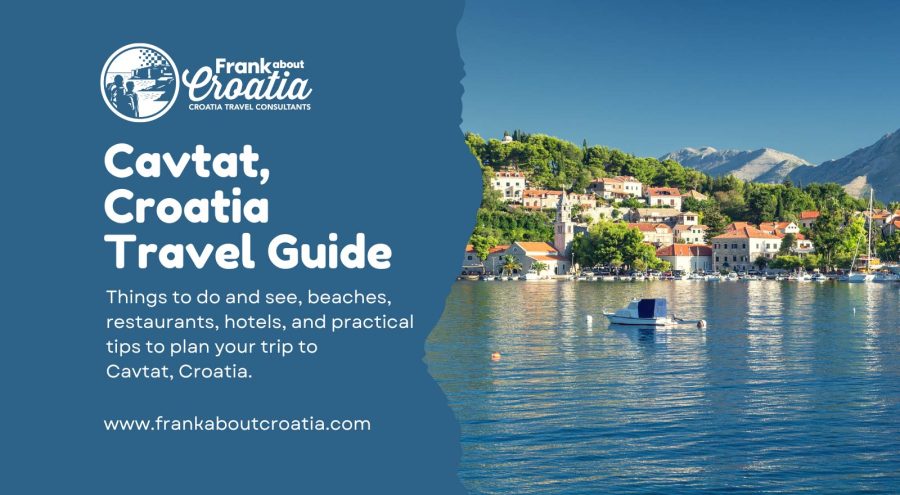
Cavtat enjoys warm summers and mild winters, making June to September the most popular time to visit, while spring and autumn provide a quieter, more affordable stay. Two to three days are enough to see the highlights, though many travelers use Cavtat as a base for day trips to Dubrovnik, Konavle Valley, Montenegro, and Bosnia and Herzegovina. Thanks to its proximity to Dubrovnik Airport and good road and sea connections, Cavtat is easy to reach by plane, car, bus, or boat. With its range of hotels, beaches, restaurants, and cultural attractions, Cavtat offers a relaxed alternative to Dubrovnik’s crowds, perfect for couples, families, and culture seekers alike. To make the most of your trip, our travel consultations help you connect Cavtat with the wider Croatia itinerary, ensuring seamless transfers, local experiences, and authentic tours tailored to your interests.
What's Inside
What Is Cavtat?
Cavtat (pronounced TSAV-tat) is a small coastal town in southern Croatia, 20 km (12 miles) south of Dubrovnik, along the Adriatic Sea. Cavtat is part of the Konavle region in Dubrovnik-Neretva County, and serves as its main tourist and cultural center. Cavtat’s population is approximately 2,200 residents. Cavtat sits at sea level on a sheltered Rat peninsula that forms a natural harbor, framed by pine-covered hills and pebble beaches. Cavtat’s Old Town has a compact layout and the Mediterranean character with narrow stone lanes, small squares, and historic houses topped with terracotta roofs. Cavtat was once the Roman colony of Epidaurum, a thriving port that stood as a gateway between the Adriatic and inland Illyrian territories. Today, the town’s historical layers are revealed in landmarks such as the Church of St. Nicholas, the Illyrian necropolis, and the mausoleum of the Račić family, a striking white stone monument designed by the celebrated Croatian sculptor Ivan Meštrović. Cavtat is also the birthplace of Vlaho Bukovac, one of Croatia’s most prominent painters, and Baltazar Bogišić, a distinguished 19th-century jurist and academic. Beyond its monuments, Cavtat’s daily life unfolds along the palm-lined seaside promenade, where fishing boats sway in the harbor and waterfront cafés overlook the clear, blue waters. The coastline offers a mix of pebble and rocky beaches shaded by pines, while the surrounding countryside blends vineyards, olive groves, and small rural hamlets. The mild Mediterranean climate shapes a year-round rhythm of outdoor living, with long, sunny days in summer and mild, temperate winters. Cavtat attracts around 170.000 travelers yearly looking for a quieter alternative to Dubrovnik. The town’s location at the latitude 42.5814° N and longitude 18.2186° E makes Cavtat a good base for visiting Dubrovnik, Montenegro, and the southern Dalmatian islands.
Where Is Cavtat Located?
Cavtat is located in the southernmost part of Croatia, along the Adriatic Sea coast. Cavtat lies 20 kilometers (12 miles) southeast of Dubrovnik, and only 5.5 kilometers (3.4 miles) from Dubrovnik Airport. Cavtat is 30 kilometers (19 miles) northwest of the border with Montenegro and about 15 kilometers (9.3 miles) west of Bosnia and Herzegovina. Administratively, Cavtat belongs to the Konavle region within Dubrovnik-Neretva County. Distances from Cavtat to major cities include 250 kilometers (155 miles) from Split, 630 kilometers (390 miles) from Zagreb, 75 kilometers (46 miles) from Kotor in Montenegro, 145 kilometers (90 miles) from Mostar in Bosnia and Herzegovina, and 40 kilometers (25 miles) from Trebinje in Bosnia and Herzegovina. The location makes Cavtat convenient for exploring southern Dalmatia, Montenegro, and parts of Bosnia and Herzegovina on day trips. Road connections link Cavtat with Dubrovnik via the D8 coastal highway. Although Cavtat is geographically distant from Croatia’s main urban centers, it is highly accessible. Cavtat’s proximity to Dubrovnik Airport makes it one of the easiest Adriatic towns to reach for international travelers. The area’s relative remoteness from central and northern Croatia was historically due to a narrow strip of Bosnian coastline at Neum, which interrupted continuous road travel. However, the opening of the Pelješac Bridge in 2022 restored uninterrupted road access, improving connectivity between Cavtat, Dubrovnik, and the rest of Croatia. Cavtat faces the open sea to the west, with views of the Elaphiti Islands, and is sheltered by low hills inland.
Below is an interactive map showing location of Cavtat.
What Is the Best Time to Visit Cavtat?
The best time to visit Cavtat is from mid-June to mid-September for warm sea temperatures, long daylight hours, a lively waterfront atmosphere, and full access to Cavtat’s beaches, activities, boat trips, and events. The shoulder months are a pleasant alternative for those who prefer fewer crowds and cooler weather.
List below explains what to expect during different travel periods.
- High Season (June–August). Cavtat is busiest in summer, with average daytime temperatures of 28–30 °C (82–86 °F) and sea temperatures reaching 25 °C (77 °F). Beaches and the promenade are lively, and all restaurants, cafés, and excursion providers operate at full capacity. Visitors from the UK, Germany, France, and the USA are most numerous during this time. Prices for accommodation and flights reach their peak, often double compared to spring or autumn. Cavtat Summer Carnival in July and various music evenings in August bring additional atmosphere, but expect crowded promenades and higher demand for parking.
- Shoulder Seasons (April–May and September–October). These months offer more balanced experience in Cavtat. Spring and early autumn bring mild weather, averaging 20–25 °C (68–77 °F) with sea temperatures around 22–24 °C (72–75 °F) in September. Tourist numbers are lower, hotel rates are 30–40% cheaper than in peak summer, and flights are more affordable. The Easter period in spring, and September’s Epidaurus Music Festival highlight cultural events during this time. These months are ideal for sightseeing, hiking, and enjoying beaches without crowds.
- Low Season (November–March). Winter in Cavtat is quiet, with average daytime temperatures around 12–15 °C (54–59 °F). Rain is more frequent, and many tourist-oriented businesses close until spring. Hotel and apartment rates are at their lowest, with some properties offering discounts of up to 60%. Flights to Dubrovnik Airport are fewer but remain available year-round. This period is suited for visitors looking for a peaceful retreat, local atmosphere, and lower costs rather than beach holidays.
How Many Days Is Enough To Visit Cavtat?
Two to four days in Cavtat is enough time to explore Cavtat Old Town, enjoy the beaches, walk the seaside promenade, and visit cultural landmarks like the Vlaho Bukovac House and Racic Mausoleum. This time frame of two to four days in Cavtat also leaves room for a boat trip to Dubrovnik or nearby islands.
Find below Cavtat itineraries and things to do based on your length of stay.
- 1 Day in Cavtat. One day in Cavtat suits travelers on a day trip from Dubrovnik or cruise visitors. The itinerary can include a morning of sightseeing, lunch at a waterfront restaurant, an afternoon of swimming at Rat or Žal Beach, and a drink at Little Star Beach Bar.
- 2 Days in Cavtat. Two days give you time to explore Cavtat’s cultural side and leisure spots. On day one, tour the old town and museums, including the Vlaho Bukovac House and Baltazar Bogišić Collection. On day two, enjoy beach time, walk the Rat Peninsula trail, and take a boat trip along the coast.
- 3 Days in Cavtat. Three days in Cavtat allow for a full mix of sightseeing, relaxation, and excursions. Dedicate one day to exploring landmarks, another day to the beaches and boat trip to Dubrovnik, and use the third day for a half-day trip to Konavle vineyards, Sokol Tower, or the Elaphiti Islands.
- 4+ Days in Cavtat. Staying four days or longer lets you settle into Cavtat’s slow pace. Combine cultural visits, coastal walks, and relaxed beach days with day trips to Dubrovnik, Montenegro, or the nearby village of Mlini. Enjoy multiple swims in the clear Adriatic, take long coastal walks, and unwind during quiet evenings by the sea. Longer stays also give you time to enjoy local festivals, seasonal events, and more of the Konavle region.
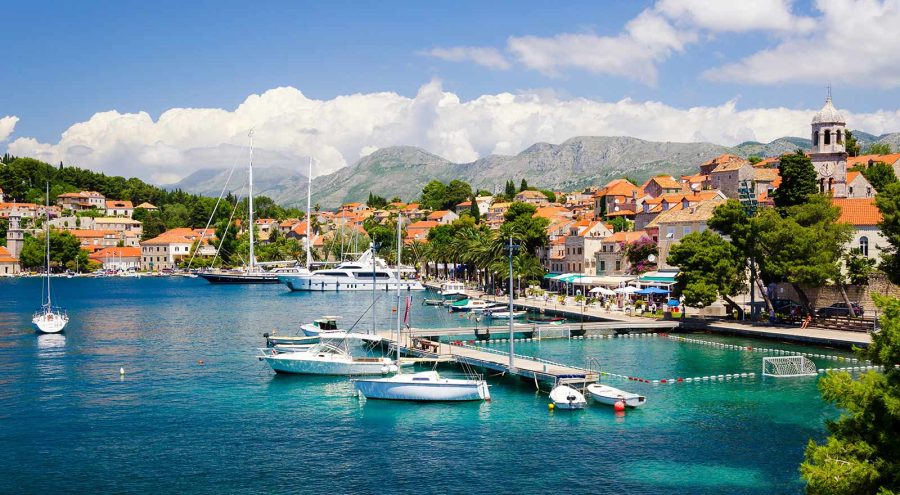
How to Get to Cavtat, Croatia?
Travelers can reach Cavtat by air, road, and sea. The fastest and most common way to get to Cavtat is by plane via Dubrovnik Airport (DBV), which is 5.5 km (3.4 miles) from Cavtat. The short transfer time makes Cavtat one of the most accessible destinations on the southern Dalmatian coast.
The main transportation options to reach Cavtat, Croatia are listed below.
- By Plane. The quickest way to get to Cavtat is by flying into Dubrovnik Airport (DBV), only 5.5 kilometers (3.4 miles) away. The airport receives direct flights from major European cities and seasonal connections from the USA (Newark) and the Middle East (Dubai, UAE). A taxi or private transfer from the airport to Cavtat takes less than 10 minutes, and it costs between €15 ($17.5, £13.1) and €25 ($29.2, £21.9) per vehicle.
- By Car. Driving to Cavtat from Dubrovnik takes about 30 minutes via the D8 coastal road. From Zagreb, the journey is about 630 kilometers (390 miles) and 6 to 7 hours via the A1 highway and the Pelješac Bridge. From Split, the journey is around 3.5 hours (250 km / 155 miles). Rental cars are convenient if you plan to explore the Konavle countryside or make day trips.
- By Bus. Local bus no 10 operated by Libertas run between Dubrovnik and Cavtat throughout the day, taking about 30 to 40 minutes. However, there is no convenient direct line from Dubrovnik Airport to Cavtat. Local line 38 operates only during the school year, weekdays only, and not on public holidays. For airport arrivals, a taxi or transfer is more reliable. Long-distance buses from other Croatian cities arrive at Dubrovnik’s main bus station, from where you can transfer to a local bus or taxi.
- By Sea. In summer, regular boats connect Dubrovnik’s Old Port to Cavtat. The trip takes about 45 to 60 minutes, passing scenic bays and small islands. Multiple boat companies, like Adriana and Vivado, operate on this route. Tickets cost around €10 ($11.7, £8.7) per person one way, and €15 ($17.5, £13.1) return.
- Alternative Airports. Split Airport and Tivat Airport are alternative airports to consider beyond Dubrovnik. Split Airport is located about 230 kilometers (143 miles) to the northwest of Cavtat. Another nearby choice is Tivat Airport in Montenegro, roughly 50 kilometers (31 miles) away. While it requires crossing the border, it’s a practical option for travelers combining Montenegro and southern Croatia in one trip. Both airports are best reached by rental car or private transfer, as direct public transport connections to Cavtat are limited.
What Is the Best Way to Travel From Dubrovnik to Cavtat?
The best way to travel from Dubrovnik to Cavtat is by road along the Adriatic coastal route. Cavtat lies only 20 kilometers (12 miles) southeast of Dubrovnik, and the buses are frequent year around. Other travel options between Dubrovnik and Cavtat include seasonal boat service, private transfers or taxis, and rental car.
The main transportation options from Dubrovnik to Cavtat are listed below.
- By Bus (Line 10 Cavtat). Libertas operates bus line 10 between Dubrovnik’s main bus station and Cavtat. Buses depart from Dubrovnik’s main bus station and Pile Gate, running every 30 to 60 minutes throughout the day. The ride takes 30 to 40 minutes and costs about €4 ($4.7, £3.5) one way.
- By Boat. Water taxis and boats run multiple times a day between Dubrovnik’s Old Port and Cavtat during the summer months. The 45 to 60 minute boat ride fromm Dubrovnik to Cavtat offers coastal views and avoids road traffic. Boats operate several times a day from April to October, with tickets costing €10 to €15 ($11.7–$17.5, £8.7–£13.1) per person.
- By Taxi or Ride-Hail (Bolt/Uber). Taxis, app-based ride services like Bolt and Uber, and private transfers from Dubrovnik to Cavtat are faster and more flexible, covering the 20 km (12 miles) route in about 30 minutes. A taxi ride costs €40–50 ($46.7–58.4, £35–43.7) per vehicle. Driving yourself is also straightforward via the D8 coastal highway, with parking available in Cavtat’s paid lots.
- By Rental Car. Renting a car is a convenient and flexible way to travel from Dubrovnik to Cavtat, particularly for those planning to explore the wider region, such as Konavle or Montenegro. The drive takes around 25–30 minutes, and Cavtat offers easier parking options compared to Dubrovnik, making it a practical choice for road-trippers.
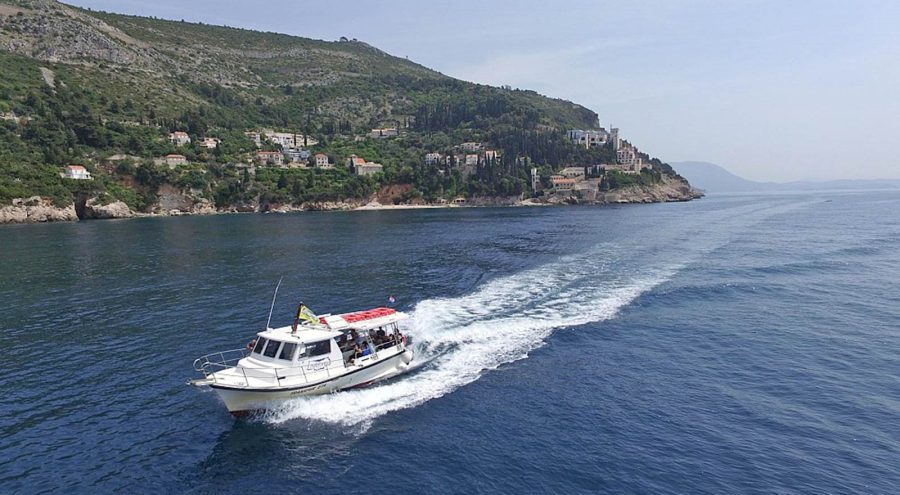
What Is the Best Way to Travel From Zagreb to Cavtat?
The best way to travel from Zagreb to Cavtat is by plane. The long overland distance between Zagreb and Cavtat makes flying the fastest and most convenient option.
The main transportation options from Zagreb to Cavtat are listed below.
- By Plane. Direct flights from Zagreb (ZAG) to Dubrovnik (DBV) take about 1 hour. Dubrovnik Airport is 5.5 kilometers (3.4 miles) from Cavtat, and the drive to town takes less than 10 minutes by taxi or private transfer. Croatia Airlines and Trade Air operate multiple daily flights, with fares starting at around €50 ($58.4, £43.7) one way when booked in advance.
- By Bus. Traveling by bus from Zagreb to Cavtat requires going via Dubrovnik. The ride takes 9 to 10 hours, covering about 630 kilometers (390 miles). Tickets cost between €35 ($41, £30.6) and €75 ($87.8, £64.8). From Dubrovnik’s main bus station, you connect to Cavtat with line 10, which adds another 30 to 40 minutes.
- By Car. Driving from Zagreb to Cavtat covers about 630 kilometers (390 miles) and takes 6 to 7 hours via the A1 highway and Pelješac Bridge. This option is scenic and allows flexibility for stops at Plitvice Lakes, Split, or the Pelješac Peninsula.
- By Train and Bus. Cavtat does not have a train station. The only possible combination is to travel by train from Zagreb to Split and then continue by bus or car to Dubrovnik and Cavtat. The journey takes over 12 hours and is not recommended.
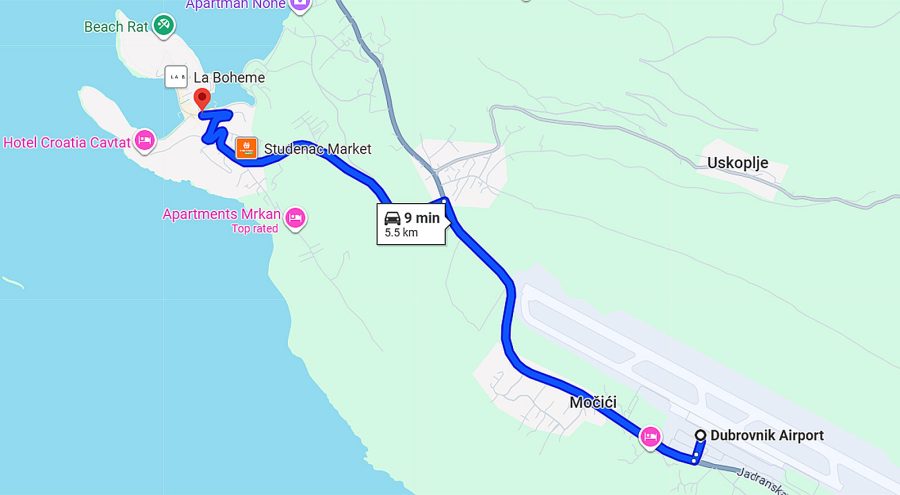
What Is the Best Way to Travel From Montenegro to Cavtat?
The best way to travel from Montenegro to Cavtat is by road. Cavtat lies just 30 kilometers (19 miles) from the Montenegrin border, making it an easy cross-border trip for visitors coming from Kotor, Budva, or Tivat.
The main transportation options from Montenegro to Cavtat are listed below.
- By Bus. Intercity buses run between Montenegrin towns and Dubrovnik year-round. There are typically 5 to 10 departures daily between Montenegro and Dubrovnik, but none stops in Cavtat. However, travelers can ask the drivers to be dropped off on the main road, and then arrange a transfer, or taxi to the center of Cavtat. Alternatively, from Dubrovnik, the local Line 10 Cavtat bus runs every 30 to 60 minutes from early morning to midnight, and taxis are also available. The journey from Kotor to Cavtat typically takes 3 to 4 hours, including transfer times in Dubrovnik. Ticket prices range from €25–35 ($29.2–41, £21.9–30.6).
- By Car. Driving from Kotor to Cavtat takes about 2 hours, while Budva to Cavtat takes around 3 hours, depending on border traffic. Multiple companies offer private transfers and taxi service between Montenegro and Cavtat, including HB Transfer, Taxyo and Kiwitaxi. A private transfer costs approx. €180 ($210, £156) per vehicle one way. The route between Montenegro and Cavtat includes a 15-minute ferry crossing at Kamenari–Lepetane to shorten the drive and avoid the long loop around the bay. The ferry saves up to 30 minutes, and the ticket costs €5 ($6, £4).
- By Ferry. There is no direct ferry connection between Cavtat and Montenegro. However, in summer, a ferry operated by Adriatic Lines connect Kotor and Budva with Dubrovnik. The ferry operates from June to September, with 4 to 6 weekly departures from Budva depending on the month, and twice weekly from Kotor. The journey takes approximately 2 hours from Budva and 3 hours from Kotor. A one-way ticket costs €50 ($58, £43), while a return ticket is €59 ($69, £51). From Dubrovnik, you can continue to Cavtat by bus or taxi. While scenic, this option requires additional transfers and takes longer overall.
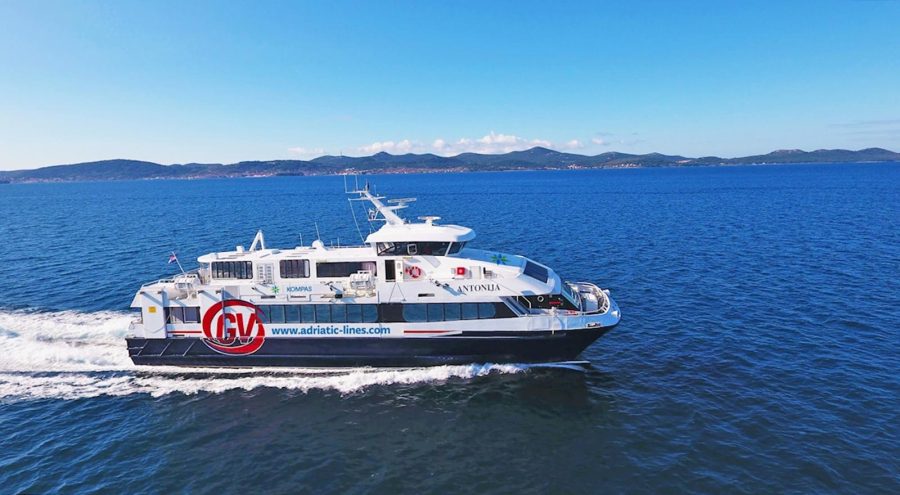
What Are the Best Things to Do in Cavtat, Croatia?
Cavtat offers far more than just a pretty harbor. It’s a perfect launchpad for both seaside relaxation and active exploration across the surrounding Konavle region, with a wide range of cultural, natural, and adventure experiences for every type of traveler.
Cavtat offers a mix of cultural landmarks, coastal walks, seaside relaxation, and active exploration across the surrounding Konavle region. Visitors combine history, art, and nature with beach time, scenic trails, and local dining. The town is compact, yet it provides a variety of activities for both short stays and longer holidays.
The best things to do in Cavtat are listed below.
- Walk the Cavtat Seafront Promenade. The tree-lined seafront promenade wraps around the Cavtat peninsula, offering scenic views of the Adriatic, shaded walkways, and easy access to swimming spots and cafés. It’s a popular path for leisurely strolls, especially at sunset.
- Explore the Old Town. Wander through narrow streets filled with stone houses, churches, and museums. Visit the Church of St. Nicholas, Rector’s Palace, and small galleries that highlight Cavtat’s cultural past.
- Visit the Vlaho Bukovac House. Discover the birthplace of Croatia’s most famous painter. The museum displays his original works, personal belongings, and a glimpse into late 19th-century life in Cavtat.
- Climb to the Račić Mausoleum. The Račić Mausoleum sits in the cemetery of St. Rocco, on a hill above Cavtat’s harbor, and was designed by renowned sculptor Ivan Meštrović. The Račić Mausoleum is built entirely from white Brač stone. The chapel of the Racic Mausoleum marks the resting place of the Račić family and offers a quiet viewpoint over the sea.
- Visit the Shell Museum in Cavtat. Located in the Franciscan Monastery near Cavtat’s waterfront, the Shell Museum displays over 3,000 seashells, corals, and marine specimens from around the world. It’s a quiet, lesser-known spot worth visiting for those interested in marine life and natural history.
- Swim at Kljucice and Žal Beaches. These two Cavtat beaches are easily accessible from the promenade and feature calm waters suitable for swimming and snorkeling. Both are family-friendly and located near restaurants and cafes.
- Go kayaking in Cavtat Bay. Kayaks can be rented from several spots along Cavtat’s waterfront, allowing visitors to explore the coastline, nearby coves, and the views of Cavtat from the sea. The water is typically calm, making it a suitable activity for beginners.
- Try water sports in Cavtat. During the summer, local operators like Gabriel or Epidarium Watersports, offer water-based activities such as parasailing, jet skiing, stand-up paddleboarding, and introductory scuba diving sessions. Most rentals and tours depart from the Cavtat harbor.
- Visit the Church of St. Nicholas. The Church of St. Nicholas, located in Cavtat’s Old Town, is a 19th-century Baroque church featuring a simple interior and religious art by Vlaho Bukovac. It functions as an active parish, and its bell tower is a prominent feature of the town’s skyline.
- See the Church of Our Lady of the Snow. The 15th-century Church of Our Lady of the Snow is located above Cavtat’s waterfront, and it is part of a Franciscan Monastery. The church features Gothic and Renaissance elements, religious artifacts, and paintings by local artists.
- Tour Villa Banac Museum. Villa Banac is a 20th-century villa-turned-museum housing the Baltazar Bogišić Collection, various artifacts, and manuscripts. Villa Banac also occasionally hosts exhibitions of local artists and art events.
- Take a boat trip to Dubrovnik. Boats depart daily from Cavtat’s harbor and arrive directly at Dubrovnik’s Old Town port. The trip offers coastal views and a relaxed alternative to buses or taxis when visiting the UNESCO-listed city.
- Relax at St. Pietro Beach Club. St. Pietro Beach Club is a 5-minute boat ride from Cavtat, offering private cabanas, swimming, and upscale dining. Set on a scenic stretch of coast, it caters to travelers seeking a premium beach experience near town.
- Ride horses in Konavle. Koyan Koral in the Konavle valley offers guided horseback tours through olive groves, farmland, and quiet village paths. Riders of all levels can enjoy these scenic routes, ending with local refreshments.
- Join an ATV Safari in Konavle. ATV tours, like Koyan Koral ATV Tours, operate in the countryside around Cavtat, where participants ride dirt trails through the hills and valleys of Konavle. The tours combine nature, local culture, and mild off-road adventure.
- Go wine tasting in Konavle. Family-owned wineries across Konavle, like Karaman or Botaro wineries, welcome visitors for tastings of regional varietals like Malvasija Dubrovačka. Tours include cellar visits, vineyard walks, and light bites featuring local ingredients.
- Visit Sokol Grad Fortress. Sokol Grad stands above the Konavle Valley as a restored medieval fortress with preserved towers and sweeping views. A visit includes a self-guided tour through the fortress grounds and exhibition areas.
- Enjoy views from Falcon Lookout. Falcon Lookout is a viewpoint just outside Cavtat near Sokol Grad. Falcon Lookout offers panoramic views of the Adriatic coastline, vineyards, and mountains. The viewpoint is a worthwhile stop for photographers, hikers, and travelers exploring the nearby countryside.
- Watch the Čilipi Folklore Show. Every Sunday in the village of Čilipi, 15-minute drive from Cavtat, locals perform traditional dances in regional costumes accompanied by music, crafts, and local speciliaties.
- Cycle through Konavle. Bikes can be rented in Cavtat or nearby villages for exploring Konavle’s flat rural roads, vineyards, and riverside trails. Routes are suitable for both casual riders and more experienced cyclists.
- Visit the Konavle County Museum. Located in Čilipi, the museum showcases traditional Konavle dress, embroidery, and household items. The building itself is a preserved example of rural architecture.
- Spend a day at Cadmos Village. Cadmos Village is an adventure park in woodland above Konavle offering zip lines, archery, and rope courses. It’s suited for families and groups looking for outdoor fun.
- Visit Kameni Mlin Stone Mill. Kameni Mlin is a working stone watermill in the Konavle countryside that today hosts traditional eco restaurant. A visit to Kameni Mlin is a great way to learn and experience Croatian olive oil and wine production and to taste the best of local produce and food.
- Have drinks at Beach Bar Luka. Beach Bar Luka, located near Cilipi, 15-minute drive from Cavtat, is a casual seaside spot for coffee or cocktails with a view.
- Escape to Pasjača, and Molunat Beaches. Pasjaca and Molunat beaches south of Cavtat offer quieter alternatives to the town center, with natural settings, fewer crowds, and excellent swimming conditions.
- Cruise to the Elaphiti Islands. Elapihiti Islands are a small archipelago near Dubrovnik, popular for its beaches, laid-back vibe, and slow-pace of life. Day trips from Cavtat to Elaphiti Islands include stops at Koločep, Lopud, and Šipan accommpanied with lunch and swimming breaks.
- Visit Mlini, Srebreno, and Kupari. Mlini, Srebreno and Kupari are seaside towns between Cavtat and Dubrovnik that offer beaches, promenades, and waterfront dining. Kupari is also home to the haunting ruins of a former military resort.
- See the Ilyrian Necropolis. Ilyrian necropolis, also known as “Croatian Pyramids” is over 2,000-year-old well preserved Illyrian burial site. It is located in a village of Mikulici, 30 minute drive from Cavtat, and offers scenic views from the top. Illyrian necropolis is a good place to visit for those who already explore wider Konavle region.
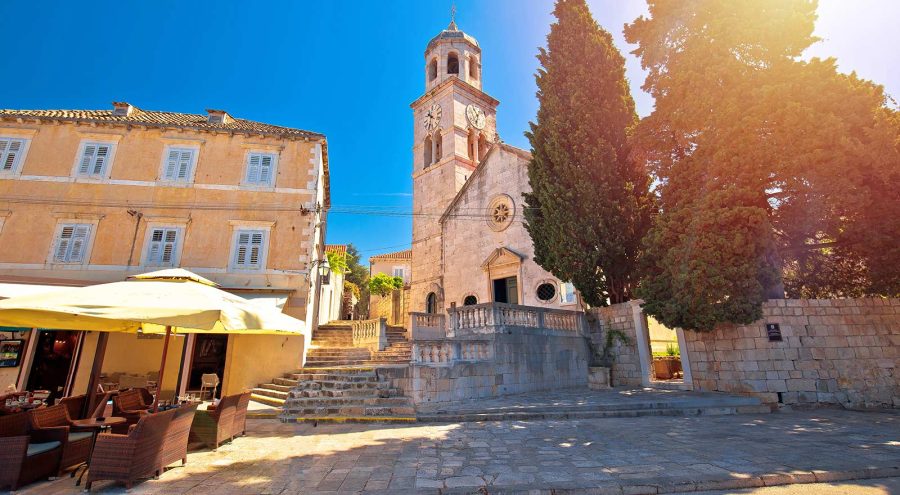
What Are the Best Things to See in Cavtat?
Cavtat is home to a collection of historic landmarks, scenic viewpoints, churches, and museums that reflect its cultural and architectural heritage. Below are the most notable things to see in and around the town.
- 1. Račić Mausoleum. The Racic Family Mausoleum is an iconic white stone chapel by Ivan Meštrović that crowns the town’s cemetery and offers stunning views over the Adriatic.
- 2. Vlaho Bukovac House and Gallery. The Bukovac House Museum, once the home of Croatia’s painter Vlaho Bukovac, features original frescoes, paintings, and personal belongings of the painter.
- 3. Cavtat Seaside Promenade. Lined with palms and pine trees, this pedestrian promenade offers tranquil views of the bay, fishing boats, and nearby islands. It’s also dotted with sculptures, bars, restaurants, shops and small art galleries.
- 4. Sustjepan Peninsula. The Sustjepan Peninsula is a peaceful coastal escape just steps from Cavtat’s harbor, with pine-shaded walking trails, sea views, and hidden swimming spots.
- 5. Church of St. Nicholas. The town’s main parish church, dating back to the 18th century, contains notable religious artworks and a peaceful courtyard often missed by passersby.
- 6. Church of Our Lady of the Snow. Overlooking Cavtat from a gentle slope, this simple yet historic church features a modest interior and panoramic views of the town and harbor.
- 7. Gray Falcon Lookout (Vidikovac Sivi Soko). This natural viewpoint just above Cavtat delivers wide-angle vistas of the coastline, town, and mountains in the /distance—especially photogenic during golden hour.
- 8. Villa Banac. Though only occasionally open for exhibitions, this seaside villa is worth admiring from the outside for its architecture and location near the promenade. It is also a home to Cavtat’s Banac Wine Bar.
- 9. Seashell Museum. Discover over 3,500 unique shells, fossils, and handcrafted souvenirs at Cavtat’s compact and fascinating Shell Museum.
1. Račić Mausoleum
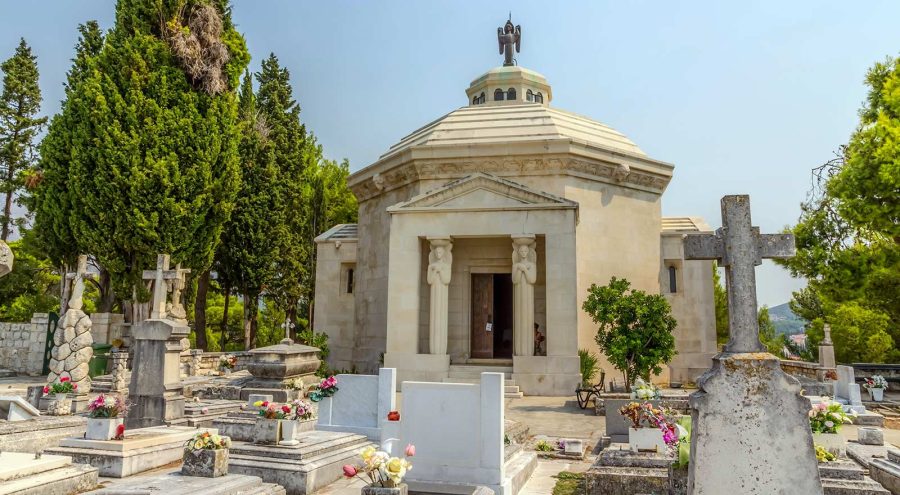
The Račić Mausoleum is a white limestone chapel located in the St. Rocco Cemetery, on a hill above Cavtat’s harbor. The Račić Mausoleum is designed by renowned Croatian sculptor Ivan Meštrović in 1921. The Mausoleum serves as the final resting place of the Račić family, prominent shipowners from the area. The building is constructed entirely from Brač stone, with symbolic carvings and no metal elements, representing the journey of life and death. Visitors reach the mausoleum by walking uphill for about 10 to 15 minutes from the waterfront, following a paved but slightly steep path. Once at the top, the site offers panoramic views of Cavtat, the surrounding sea, and nearby islands. Inside, the mausoleum features Meštrović’s sculptural work, including angelic figures and a central dome with symbolic reliefs. Most visitors spend around 20 to 30 minutes at the site. Early morning or late afternoon visits are ideal for better lighting, and less heat. Comfortable shoes are recommended, and photography is permitted outside and inside the chapel, though discreet behavior is encouraged due to the site’s sacred nature. The admission fee for the Racic Family Mausoleum is €4 ($4.60, £3.40).
2. Vlaho Bukovac House and Gallery
The Vlaho Bukovac House is a 19th-century stone house located in the heart of Cavtat’s old town, just a few steps uphill from the harbor. The Vlaho Bukovac House was the birthplace and family home of Vlaho Bukovac, one of Croatia’s most influential painters. The home now functions as a museum and gallery, preserving the artist’s legacy through original works, sketches, family artifacts, and frescoed interiors. Visitors enter the building through a shaded garden and follow a self-guided path through several rooms. Most guests spend about 30 to 45 minutes inside. The entry ticket costs €7 ($8, £6).
3. Cavtat Seaside Promenade
The Cavtat Seaside Promenade is a palm-lined, stone-paved walkway that runs along the waterfront of the old town and Cavtat harbor. The Cavtat Seaside Promenade offers uninterrupted views of the bay and islands, with easy access to cafés, restaurants, and small souvenir shops. The promenade is known for its scenic beauty, with benches, sculptures, and paved path offering uninterrupted views of the Adriatic and nearby islands. The Cavtat harbor stretch of the promenade is lively throughout the day, making it a favorite spot for both locals and visitors. The popular spots along the Cavtat Promenade are restaurants Ankora and Bugenvila, and Lucky Beach Bar. The promenade is ideal for a slow walk or a drink by the sea, and its proximity to the water gives it a relaxed, open feel. From here, the path continues toward the pine-shaded trails of the Sustjepan and Rat peninsulas.
4. Sustjepan Peninsula
The Sustjepan Peninsula is a narrow forested cape that stretches west of Cavtat’s harbor, forming a natural boundary between the town and open sea. Covered in tall pine trees and edged by rocky outcrops, the peninsula is known for its quiet walking paths, sea views, and shaded swimming spots. It’s a local favorite for those seeking a peaceful escape from the more crowded waterfront areas. Visitors can access Sustjepan by following the seaside promenade past the marina and continuing along the circular coastal path that wraps around the peninsula. The walk takes around 30–45 minutes in total and offers benches, viewpoints, and occasional beach access along the way.
5. Church of St. Nicholas
The Church of St. Nicholas is a small Roman Catholic church located on the Cavtat waterfront in the Old Town. The Church of St. Nicholas was originally built in 1484, upgraded in 1737, with its bell tower added in 1835. As the oldest parish in Konavle, the Church of St. Nicholas holds historical and religious significance. Visitors can view wooden altars, four evangelist paintings by Vlaho Bukovac, and a painting of St. Sebastian by Benedetto Gennari inside the church. The church is easy to visit while walking through Cavtat’s center and typically takes about 10–15 minutes to explore.
6. Church of Our Lady of the Snow
The Church of Our Lady of the Snow is a historic Roman Catholic church at the end of Cavtat’s harbor, attached to a Franciscan monastery founded in 1484. Inside, the Church of Our Lady of the Snow features early Renaissance artworks and a canvas by Vlaho Bukovac. The church is easy to reach on foot and is often included in routes to nearby landmarks like the Račić Mausoleum. Visitors typically spend 5 to 10 minutes inside the church. Entry is free when the church is open.
7. Gray Falcon Lookout (Vidikovac Sivi Soko)
Gray Falcon Lookout, or Vidikovac Sivi Soko, is a hillside viewpoint above Cavtat offering wide views of Zvekovica, Cavtat’s old town, the coastline, and Konavle countryside. The Gray Falcon Lookout is accessible via a 15-minute drive from Cavtat, followed by a short walk on a well-marked, level path suitable for all skill levels. Visitors stop at the Gray Falcon Lookout to take panoramic photos, observe the coastal layout, and trace Cavtat’s peninsula from above. Most spend 15 to 30 minutes at the viewpoint before returning to town or continuing toward inland Konavle.
8. Villa Banac
Villa Banac in Cavtat is a coastal mansion built in 1928, representative of countryside manor architecture typical of southern Dalmatia. Villa Banac stands near Cavtat’s seafront promenade and features clean stone lines, a tiled roof, and a terrace overlooking the bay. Cavtat’s Villa Banac functions as a multi-purpose venue. The Villa occasionally hosts cultural exhibitions, serves as a wedding location, and houses the Wine & Sushi Bar Banac. While the interior museum space is not regularly open, the outdoor terrace and bar are accessible during the tourist season. Visitors typically stop at Villa Banac while walking the promenade or for drinks with a sea view.
9. The Shell Museum in Cavtat
The Shell Museum is a a small private museum in central Cavtat featuring a collection of over 3,500 seashell specimens from oceans around the world. Highlights of Cavtat’s Shell Museum include a 160-million-year-old fossilized shell, a real pearl oyster, and shells weighing over 130 kilograms. The seashell collection emphasizes the structural variety and durability of marine life. The museum also offers handcrafted souvenirs made from authentic sea materials. The Shell Museum in Cavtat is open Monday to Friday from 10:00 AM to 6:00 PM and weekends from 10:00 AM to 4:00 PM. Admission is €7 ($8.10, £6.00), with free entry for children under 11 when accompanied by a paying adult. A typical visit lasts 20–30 minutes, and the museum is a few meters from Cavtat’s waterfront.
What Are the Best Beaches Near Cavtat?
The best beaches near Cavtat offer a mix of pebbly coves, cliffside retreats, and family-friendly swimming spots. Most Cavtat beaches are easily accessible on foot or by car.
The best beaches in Cavtat are listed below.
- Žal Beach. Žal Beach, Located on the western side of Cavtat, is a pebbly bay with clear, calm waters and a gentle slope into the sea. Cavtat’s Zal Beach is a ideal for families and has nearby cafes, loungers, and natural shade from pine trees.
- Mali Kamen Beach. Mali Kamen Beach is a small and hidden rocky beach near Cavtat’s Old Town. Mali Kamen is ideal for couples or solo travelers seeking solitude and crystal-clear water. Right above Mali Kamen Beach, Little Star Beach Bar offers refreshments with a view, making it a favorite stop for sunset drinks.
- Rat Beach. Rat Beach, situated on the east side of the Rat Peninsula, combines sun, shade, and sea access in a natural setting. Cavtat’s Rat Beach offers a combination of gentle pebble beach and rocky shores. Rat is a perfect beach for those who want to swim in deep water or enjoy a peaceful afternoon under the trees.
- Ključice Beach. A quieter alternative to Rat, Ključice Beach sits just below the pine forest path and offers direct access to the sea with natural cover. It’s a favorite among locals looking for a low-key swimming spot.
- Cavtat Beach. This informal name typically refers to the swimming area near the town center, between the Old Town and Hotel Cavtat. With concrete platforms, ladders, and proximity to shops and cafés, it’s popular with those looking to jump in the water without straying far.
- Pasjača Beach. Pasjača Beach, located below cliffs in Popovići village, is visually striking and remote. The descent to the beach involves a steep footpath, but the reward is pristine water and dramatic scenery. Pasjaca Beach is best for confident swimmers and adventurous travelers.
- St. Pietro Beach Club. St. Pietro Beach Club is located on a small island, 5 minute boat ride from Cavtat. St. Pietro Beach Club is modern beach club that combines comfort, cozy and romantic vibe in a relaxed natural environment. St. Pietro offers loungers, parasols, food service, and music, and it’s ideal for those wanting a full-service beach experience.
- Beach Bar Luka. Beach Bar Luka is a chilled-out spot in a remote bay near village of Cilipi, 15 minute drive from Cavtat. Beach Bar Luka offers direct sea access and a great location for cocktails by the water.
- Molunat Beaches. The beaches of Molunat, in the far south near the border with Montenegro, offer a slower pace, clear seas, and small bays perfect for swimming and unwinding.
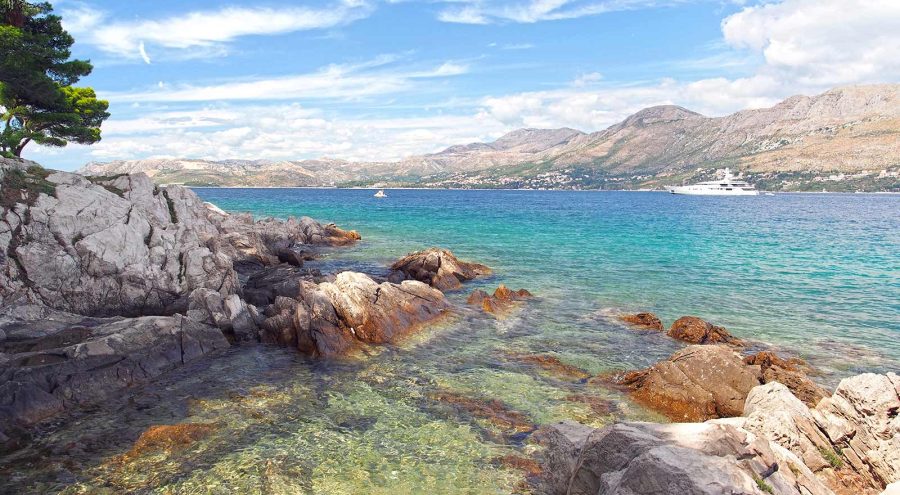
What Are the Recommended Day Trips From Cavtat?
The recommended day triips from Cavtat include visits to historic towns, scenic islands, and neighboring countries. These tours from Cavtat are easy to organize and don’t require long travel times. Personalized travel consultations are recommended to help plan day trips from Cavtat including boat trips, wine tastings, or cultural visits throughout the Konavle region and beyond.
Below is the list with the recommended day tours from Cavtat.
- Dubrovnik. Dubrovnik is just 20 km (12 mi) from Cavtat. Visit includes a walk around the famous city walls, exploring the Old Town, and visiting filming locations from Game of Thrones. Dubrovnik is ideal if you want a mix of history, shopping, and sightseeing. Dubrovnik is easily visited on a self-guiding tour from Cavtat.
- Konavle Countryside. Konavle is a peaceful valley behind Cavtat. It’s perfect for cycling, horseback riding, and visiting local wineries. You can also stop in Čilipi to watch traditional dances and folk shows on Sundays. Local agencies, like Konavle Safari, organize 4WD off-road and countryside experiences wth lunch from €89 ($104, £77) per person.
- Lokrum Island. Lokrum is a small island off the coast of Dubrovnik. The island has botanical gardens, rocky beaches, and ruins of a monastery. A visit to Lokrum Island is a popular half-day tour from Cavtat, offered by many local boat companies like Dubrovnik Boat Tours. The tour start at €60 ($70, £52) per person, including an antry ticket for Lokrum Island.
- Elaphiti Islands. The Elaphiti Islands are a group fo islands off the coast of Dubrovnik, known for their lovely beaches, and island’s vibe. The Elaphiti are a popular boat tour from Cavtat. The tour includes visiting all three biggest Elaphiti Islands, Koločep, Lopud, and Šipan in one day. Each island offers beaches, walking trails, and relaxed local life. Companies like Adriana Travel and Dubrovnik Boat Tours offer full-day Elaphiti cruises with lunch and drinks included. Price is €70 ($82, £60) per person.
- Mlini, Srebreno, and Kupari. Mlini, Srebreno and Kupari are seaside towns half-way between Cavtat and Dubrovnik. Mlini, Srebreno and Kupari have calm beaches, long promenades, and lovely seaside restaurants. Kupari is also known for its eerie, abandoned hotel complex from the Yugoslav era. These towns are easy to visit independently by taxi or local bus. Adriana and Vivado boat lines also offer boat transfers during summer. Expect to pay around €10 ($11.60, £8.70) each way for a boat ride.
- Kotor, Montenegro. Kotor is a fortified coastal town in Montenegro, 75 kilometers (47 miles) southeast of Cavtat. Kotor is easily visited on a day trip from Cavtat. Many agencies offer Montenegro day trips from Cavtat, including Select Dubrovnik. Expect to pay €65 ($76, £56) per person, including transportation and a guide.
- Mostar (Bosnia & Herzegovina). Mostar is a city in Bosnia and Herzegovina, known for its medieval Old Bridge. Mostar has Ottoman-era architecture, peaceful cafés, and a relaxed vibe. Mostar is a great day-trip option from Cavtat if you’re looking to experience a different cultural and natural setting from the typical Croatian coast. Guided day trips from Cavtat are available through Select Dubrovnik and bookable online through Viator. Prices start at €65 ($76, £56) per person.
- Arboretum Trsteno. Arboretum Trsteno is a Mediterranean garden in a village of Trsteno, 36 kilometers (22 miles) from Cavtat. The Trsteno arboretum was established by Gucetic – Gozze family in the late 15-century. The arboretum overlooks the sea, and features a a wide variety of exotic plants, historic aqueduct, a baroque Neptune fountain, a Renaissance villa, a small chapel, and nearly 500 years old plane tree. The arboretum also served as a filming location for the TV series “Game of Thrones.” Arboretum entry is €10 ($11.60, £8.70) per person. Arboretum in Trsteno is easily accessible by public transport, private transfer, or by car.
- Sokol Grad Fortress. Sokol Grad is a restored fortress in Konavle, 20 kilometers (12.4 miles) southeast of Cavtat. Sokol Grad stands on a cliff and offers sweeping views of the valley. It’s one of the best historic sites near Cavtat. Entry to the Sokol Fortress is €10 ($11.60, £8.70). Travelers visit Sokol Grad from Cavtat independently by car or book a private transfer.
- Pelješac Peninsula and Ston. The Pelješac peninsula, located 70 kilometers (43.5 miles) northwest of Cavtat, is famous for wine, oysters, nice beaches and historical Ston Walls and Salt Pans in Ston. This trip is perfect for food lovers. Transfers Cavtat and Tours By Vespa both offer guided tours from Cavtat to Peljesac Peninsula.The prices start at €150 ($176, £130) per person.

How to Get Around Cavtat?
Getting around Cavtat is simple because the town is compact and walkable. Most attractions, beaches, and restaurants are within a short distance of the old town and promenade. The town center and promenade are mostly flat and accessible for those with limited mobility. However, Cavtat Old town, many attractions, like the Račić Mausoleum, as well as accommodations, require climbing stairs or walking uphill. A car is not necessary for staying in Cavtat itself, but it can be useful for day trips into Konavle, Peljesac, or Montenegro.
The main ways to get around Cavtat are listed below.
- On Foot. Cavtat is best explored on foot. The historic town center, seafront promenade, beaches, and most restaurants are all within easy walking distance. However, everything beyond the waterfront, including the Old Town and residential areas, is on hilly slopes, with stairs and inclines throughout. The coastal path around the peninsula is shaded and easy to walk.
- By Taxi. Taxis in Cavtat are available and useful for short trips to Dubrovnik Airport (about 10–15 minutes) or nearby villages. It’s best to arrange the taxis in advance or ask your accommodation to call one for you. You can also use ride-sharing services, although they are not as widely available in Cavtat as in Dubrovnik.
- By Bus. Local buses connect Cavtat with Dubrovnik and other Konavle villages. The Line 10 Cavtat bus is the most commonly used route, with stops throughout the area and a reliable schedule during the tourist season.
- By Bicycle or E-Bike. Bicycles and electric bikes are available for rent in Cavtat and ideal for exploring the surrounding countryside or Konavle trails. Some accommodations offer bike storage or even free rentals.
- By Boat. Water taxis and excursion boats run between Cavtat, Dubrovnik, and the Elaphiti Islands in the summer months. Traveling around Cavtat area by boat is a scenic and enjoyable way to travel without using the roads.
- By Car. A car is not necessary if you’re staying in Cavtat itself. However, the car is useful if you plan to explore inland Konavle, go on day trips to Montenegro, or visit more remote beaches and villages.
What Are the Parking Options in Cavtat?
Parking options in Cavtat include a main public lot, hotel and apartment guest parking, and limited street parking near the center. Parking in Cavtat is available, but it becomes competitive during the summer months.
Below list shows the Cavtat’s main parking types and conditions.
- Public Parking Lot near Old Town. Cavtat main public lot is the central parking facility in Cavtat, located near the bus terminal and marina. This central public lot in Cavtat offers around 240 car spaces and an additional 25 spaces for motorcycle parking. Rates during peak season are approximately €3 ($3.5, £2.6) per hour. Parking in Cavtat can be paid via coin-operated machines, SMS, or the PayDo mobile app.
- Hotel and Apartment Parking. Many accommodations in Cavtat offer reserved guest parking, included in the room price. Hosts in Cavtat often assist in securing access to nearby lots if parking is not on-site. Travelers arriving by car should always confirm that parking is provided before booking accommodation.
- Street Parking Restrictions. The historic core of Cavtat is off-limits to non-resident vehicles. Automatic barriers restrict entry, and unauthorized access results in fines. Designated parking is available just outside the pedestrian zone.
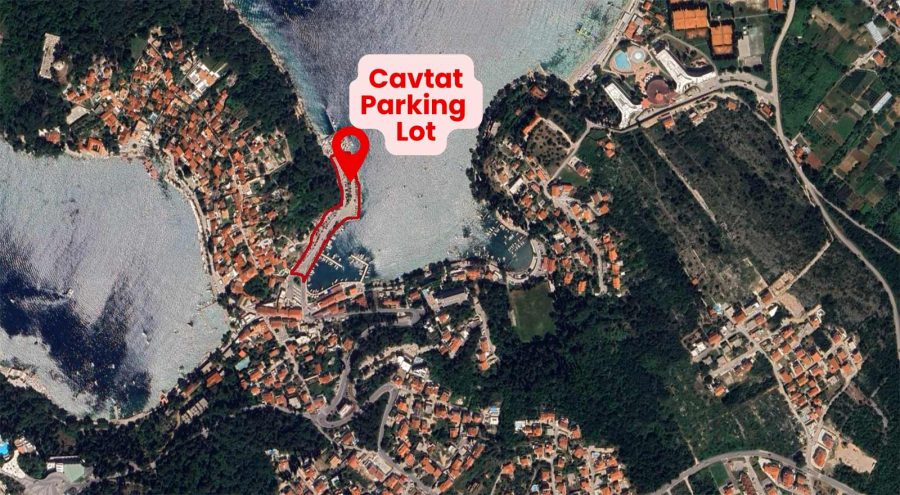
What Are the places to Stay in Cavtat?
Find below a list of places to stay in Cavtat, Croatia.
- Hotel Croatia. Hotel Croatia is a 5-star resort located on a forested peninsula just 750 meters (0.5 miles) from Cavtat’s Old Town. The property features indoor and outdoor pools, private beaches, multiple restaurants, a wellness center, and panoramic views of the Adriatic Sea and Dubrovnik. Its location makes it ideal for guests looking for luxury by the sea with easy access to nearby cultural and historical attractions. Travel consultations are a good option for guests staying at the Hotel Croatia and want to explore beyond the resort. Travel consultations help visitors plan personalized day trips to the Konavle region or boat excursions to the Elaphiti Islands.
- Hotel Albatros. Hotel Albatros, situated at the northern entrance to Cavtat, is a 4-star beachfront hotel known for its family-friendly amenities, all-inclusive packages, and access to a pebble beach. The Albatros hotel is located just 850 meters (0.5 miles) from the town center and 5 kilometers (3.1 miles) from Dubrovnik Airport. The all-inclusive hotel Albatros is well suited for travelers who want convenience, especially families with children. Guests can enhance their experience by booking tailored itineraries and consultations to explore nearby villages, wine estates, or cultural events in the area.
- Hotel Supetar. Hotel Supetar is a boutique 3-star hotel located directly on Cavtat’s seafront promenade. This heritage property is ideal for guests seeking quiet elegance, and it’s particularly suitable for travelers with mobility issues due to its flat access and central location. The harbor, museums, and churches are within a 5-minute walk. Those staying at Hotel Supetar can benefit from curated travel planning services to discover hidden beaches, local art galleries, and culinary experiences off the beaten path.
- Apartments Olea. Apartments Olea is a modern apartment complex in Cavtat, located 100 meters (0.5 miles) from the main promenade. The apartments Olea offer self-catering studios and one-bedroom units with fully-equipped kitchens, offsite parking in the price, and some with private terraces. Apartments Olea is a good choice for couples who prefer central location and home-like amenities.
- Apartments Villa Royale. Apartments Villa Royale is a beachfront property located right at the Cavtat seaside promenade. The Apartments Villa Royale features studio and one-bedroom apartments with sea views. Each unit at the Apartments Villa Royale includes air-conditioning, a private bathroom, a fully equipped kitchen, free WiFi throughout, and sea views. Guests consistently rate it highly for cleanliness, attentive hosting, and its prime waterfront location.
- Villa AnMari. Villa AnMari is a private property featuring 1- and 3-bedroom apartments. Villa Anmari is situated 0.2 kilometers (0.1 mile) above Cavtat’s harbor. The Villa AnMari The Cavtat View Residence includes a rooftop pool with spectacular views, multiple apartrments with fully equipped kitchens. It’s ideal for families or small groups looking for comfort and independence. Guests often opt for itinerary consultations to create a well-balanced trip that combines relaxation at the villa with curated wine tastings, heritage visits, or seaside dining.

What Are the Best Places to Eat in Cavtat?
Cavtat has a good selection of restaurants, ranging from casual seaside konobas to fine dining spots with panoramic views. Fresh seafood, Dalmatian classics, and regional wines from Konavle dominate most menus.
Find listed below the best places to eat in Cavtat.
- Restaurant Bugenvila. Restaurant Bugenvila is located on Cavtat’s waterfront promenade, just steps from the harbor. The restaurant is known for its fine-dining atmosphere and elegant terrace with sea views. The menu highlights modern Mediterranean cuisine prepared with seasonal ingredients, including seafood risotto, grilled Adriatic fish, and tasting menus paired with Croatian wines. Visitors often recommend the chef’s inventive starters and attentive service, making Bugenvila a top choice for special occasions.
- Restaurant Ankora. Restaurant Ankora is set directly on the waterfront, in Cavtat’s Old Town. The family-run restaurant offers a welcoming atmosphere and outdoor seating overlooking the sea. Its menu focuses on traditional Dalmatian dishes such as black risotto, octopus salad, and grilled calamari, along with hearty meat options. Guests appreciate the relaxed vibe, fair pricing, and generous portions.
- Ludo More. Ludo More is set directly on the waterfront near Tiha Bay, 500 meters (0.3 miles) from the town center. The restaurant is popular for its cozy setting and a menu that blends traditional Croatian flavors with modern presentation. Signature dishes include tuna steak, seafood pasta, and daily specials prepared with freshly caught fish. The wine list features selections from Konavle and Pelješac. Diners often highlight the friendly staff and casual yet stylish ambiance.
- La Boheme. La Boheme is also located on Cavtat’s promenade, but with terrace a bit further away from the waterfront. La Boheme is a bistro-style restaurant, known for its artistic atmosphere, attentive service, and modern Mediterranean menu, with some international favorites like burgers and Caesar salad. Popular dishes include fresh sea bass, fried calamari, and seafoodpasta. Guests praise its creative presentation, intimate ambiance, and carefully selected Croatian wines.
- BokunBocun. BokunBocun is a casual eatery located on the seafront promenade, about 350 meters (0.22 miles) from Cavtat Harbor. It is popular for its relaxed setting, homemade desserts, and simple Mediterranean comfort food. The menu includes light seafood plates, salads, pastas, and daily cakes. Visitors enjoy stopping at Bokun for a light lunch or dinner with a view of the harbor.
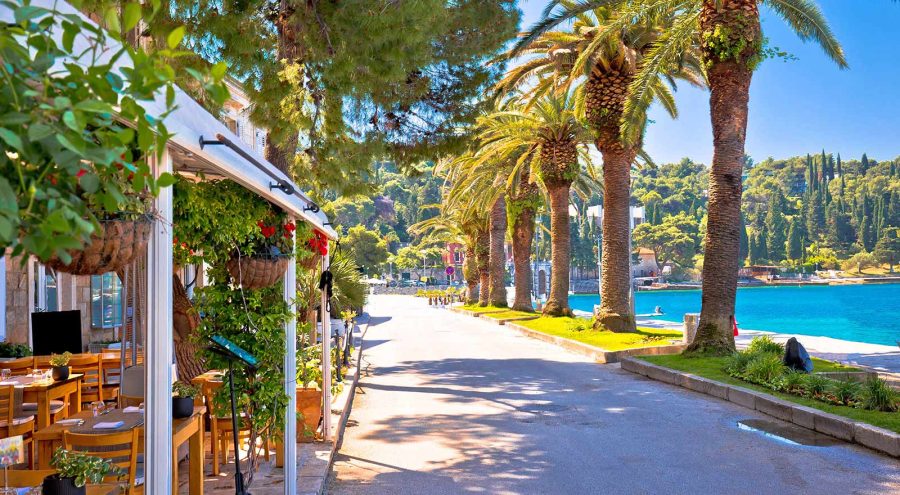
How Is Cavtat Nightlife?
Cavtat’s nightlife is quiet compared to Dubrovnik. Evenings are centered around seaside cafés, wine bars, and restaurants along the promenade. Live music is common in summer, but there are no large clubs. For late-night options, many visitors head to Dubrovnik, 20 kilometers (12 miles) away.
What Are Some Practical Travel Tips for Visiting Cavtat?
Practical tips help travelers set the right expectations when planning a holiday in Cavtat. The town is safe, easy to navigate, and offers a more relaxed atmosphere than nearby Dubrovnik, but costs and experiences vary depending on season and travel style.
The most useful tips for visiting Cavtat are listed below.
- Is Cavtat Safe? Cavtat is a safe destination for tourists. Violent crime in Cavtat is rare, and most visits are trouble-free. Normal precautions against petty theft, such as keeping belongings secure on the beach or in crowded areas, are advised. Families, solo travelers, and retirees find Cavtat welcoming and low-risk.
- Is Cavtat Expensive? Cavtat is less expensive than Dubrovnik but still ranks above average for Croatia. A mid-range restaurant meal costs €25–40 ($29.2–46.7, £21.9–35) per person, while hotel prices in high season often range from €120 ($140, £105) for a studio apartment to €350 ($410, £300) per night for a double room in 5* hotel. Traveling in spring or autumn reduces accommodation costs by 30–40%.
- Is Cavtat Worth Visiting? Cavtat is worth visiting for its beaches, good tourist infrastructure, vicinity to Dubrovnik, and relaxed pace. Cavtat’s proximity to Dubrovnik makes it a good alternative for those seeking quieter surroundings with easy access to major attractions.
Is Cavtat Worth Visiting?
Cavtat is worth visiting because of its location in the southernmost part of Croatia, which guarantees warm and sunny weather for much of the year. Its proximity to Dubrovnik Airport makes it one of the most convenient places to reach in Dalmatia, while its closeness to Dubrovnik allows travelers to enjoy cultural and sightseeing opportunities at a more relaxed pace.
What makes Cavtat a good destination in Croatia to visit is listed below.
- Konavle Valley. Nearby countryside with hiking, cycling, wine tasting, and food tours.
- Southern Location. Warm, sunny climate with long beach days from late spring to early autumn.
- Convenient Access. Only 5.5 kilometers (3.4 miles) from Dubrovnik Airport, making transfers quick and easy.
- Proximity to Dubrovnik. Close enough for sightseeing, yet quieter and less crowded for everyday holiday life.
- Tourist Infrastructure. Wide range of hotels, apartments, restaurants, beaches, and water sports.
On the other hand, Cavtat does have a few downsides. Nightlife is limited, with evenings mostly spent in cafés and restaurants rather than in bars or clubs. The town is small and can be fully explored in two to three days, meaning longer stays usually rely on day trips for variety. In July and August, Cavtat also attracts more visitors, especially yachts and hotel guests, which can make the promenade and beaches feel crowded.
Cavtat appeals most to couples and families looking for a safe and peaceful holiday spot with beaches, seaside walks, and a welcoming atmosphere. Culture lovers also find it rewarding, with historic landmarks, museums, and the option to explore Dubrovnik nearby. Travelers who enjoy outdoor activities appreciate the easy access to the Konavle Valley, where hiking trails, cycling routes, and wine or food tours add variety to a coastal stay.
Should You Stay in Dubrovnik or Cavtat?
Whether you shoud stay in Dubrovnik or Cavtat depends on type of holiday you want. Dubrovnik is best for travelers who want to be in the center of a UNESCO World Heritage Site. Durovnik offers world-famous landmarks, lively nightlife, and many restaurants and cultural events. Staying in Dubrovnik gives direct access to the Old Town, its walls, museums, and the Dubrovnik Summer Festival. Dubrovnik suits first-time visitors, history lovers, and anyone who enjoys a busy city atmosphere. Cavtat is the right choice for travelers seeking a quieter pace. Cavtat offers beaches, a tree-lined promenade, and a strong local feel. Cavtat is only 20 kilometers (12 miles) from Dubrovnik, so day trips are easy. Cavtat provides a more relaxed base with lower prices, fewer crowds, and quick access to Dubrovnik Airport. Cavtat is ideal for families, couples, and travelers who want to combine sightseeing with a beach holiday and outdoor activities in the Konavle Valley.
Should You Stay in Mlini or Cavtat?
You should rather stay in Cavtat than Mlini because Cavtat is the better choice than Mlini for an all-round holiday experience. Cavtat has a compact old town, a lively promenade, and stronger tourist infrastructure with more restaurants, bars, and accommodation options. Cavtat also offers quicker access to the Konavle Valley, Montenegro, and other nearby areas while still being only 20 kilometers (12 miles) from Dubrovnik. Mlini is closer to Dubrovnik but has fewer options for dining and nightlife, and its atmosphere is more hectic because the main coastal highway passes through the village.
How Can I Get Help Planning My Croatia Itinerary?
Planning a trip to Cavtat often ties into a wider Croatia itinerary that includes Dubrovnik, the Konavle Valley, and nearby islands. While Cavtat itself is easy to explore, fitting it into a longer journey through Croatia takes careful planning. As local travel consultants, we help travelers design seamless itineraries that connect Cavtat with the rest of the country. We provide expert advice on where to stay, how to get around, and which experiences to prioritize, ensuring you save time, avoid common mistakes, and enjoy Croatia in the best possible way.
Is It Worth Hiring a Travel Consultant When Planning a Trip to Cavtat?
Yes, it is worth hiring a travel consultant when planning a trip to Cavtat. As locals with a deep understanding of Croatia’s tourist offer, we help you choose the right accommodation, connect you with reliable local providers, and answer all your questions about logistics, transfers, and daily planning. Our consultations cost only a fraction of a full-service travel agency, yet they save you time, reduce stress, and ensure you get the best experience from your holiday in Cavtat and beyond.
